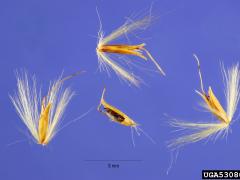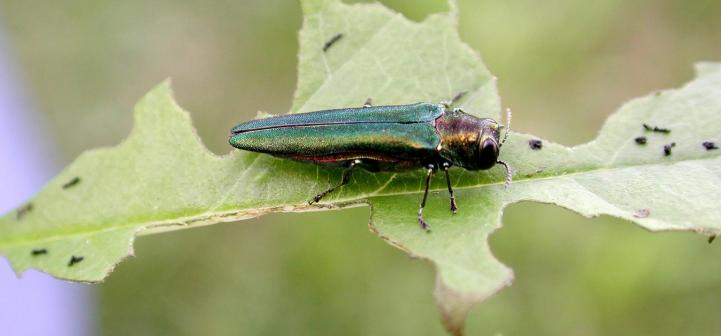Invasive Species: Miscanthus sinensis, Chinese Silvergrass
Chinese silvergrass is a densely bunched grass that grows up to 12 ft. (3.7 m) tall and invades roadsides, forest edges, old fields, and other disturbed areas throughout the United States. The leaves are up to 18 in. (45 cm) long, slender, and upright to arching, with sharp tips and rough margins. The midribs are silvery. The terminal panicle is fan-shaped, 2 ft. (0.6 m) in length, and silvery to pink. Flowering occurs in late summer. Fruits are rough and about 0.12 to 0.16 in. (3 to 4 mm) long. They have twisted bristle tips. Chinese silvergrass escapes from ornamental plantings and can form large clumps along disturbed areas, displacing native vegetation. The grass is extremely flammable and increases fire risks of invaded areas. Chinese silvergrass is native to Asia and was introduced in the United States for ornamental purposes during the late 1800s.
What are invasive species, and why should we be concerned about them?
Taxonomy: Scientific and Common Names for This Species
Cyperales > Poaceae > Miscanthus sinensis Anderss.
Synonym(s): eulalia, Chinese plume grass, zebra grass, eulaliagrass
Miscanthus sinensis – USDA PLANTS Profile
Distribution Maps
Chinese silvergrass – The reported distribution of this invasive species across the United States (Source: Invasive Plant Atlas of the United States)
Up-to-the-minute distribution maps and why they are important
Reporting This Invasive Species
What is the best way to report the occurrence of an invasive species?
How to report an invasive species sighting to EDDMapS – Early Detection & Distribution Mapping System
EDDMapS – Report an invasive species to EDDMapS.
County Extension Offices – Find your county Extension office on this map provided by USDA.
How to Identify
This invasive species can be identified by looking for the characteristics described in the paragraphs that follow.
Grass
Chinese silvergrass is a densely bunched grass that grows up to 12 ft. (3.7 m) tall.
 |
 |
| Arthur E. Miller, USDA APHIS PPQ, bugwood.org | Lauren Quinn, bugwood.org |
Foliage
The leaves are up to 18 in. (45 cm) long, slender, and upright to arching, with sharp tips and rough margins. The midribs are silvery.
 |
 |
| James H. Miller, USDA Forest Service, bugwood.org | James H. Miller, USDA Forest Service, bugwood.org |
Flower
The terminal panicle is fan-shaped, 2 ft. (0.6 m) in length, and silvery to pink. Flowering occurs in late summer.
 |
 |
| Chris Evans, River to River CWMA, bugwood.org | Chris Evans, River to River CWMA, bugwood.org |
Fruit
Fruits are rough and about 0.12 to 0.16 in. (3 to 4 mm) long. They have twisted bristle tips.
 |
 |
| Chris Evans, River to River CWMA, bugwood.org | Steve Hurst, USDA NRCS PLANTS Database, bugwood.org |
Native Species That Resemble Chinese Silvergrass
– Images at invasive.org
| bugwood.org | bugwood.org |
– Images at invasive.org
| bugwood.org | bugwood.org |
Additional Images for Chinese Silvergrass
Chinese silvergrass – Images at invasive.org
Learning Resources for Chinese Silvergrass
Miscanthus sinensis Identification Card – U.S. Fish and Wildlife Service
Miscanthus sinensis Fact Sheet – U.S. Fish and Wildlife Service
Additional Information, Biology, Control and Management Resources
Control and management recommendations vary according to individual circumstances. Location, habitat, weather, and a variety of other conditions are factors that help determine the best treatment choice. To find the safest and most effective treatment for your situation, consult your state’s land-grant institution. If you will use chemicals as part of the control process, always refer to the product label.
United States Land Grant University System – Find your Land Grant University’s College of Agriculture, University Cooperative Extension Service, or other related partner on this map provided by USDA.
Fact Sheet – Pennsylvania Department of Conservation and Natural Resources
A Field Guide for the Identification of Invasive Plants in Southern Forests – USDA Forest Service
A Management Guide for Invasive Plants of Southern Forests – USDA Forest Service
Plant Invaders of Mid-Atlantic Natural Areas – National Park Service and U.S. Fish and Wildlife Service
Southeast Exotic Pest Plant Council Invasive Plant Manual – Southeast Exotic Pest Plant Council (SE-EPPC)
Invasive Plant Atlas of New England – University of Connecticut
Weed of the Week – USDA Forest Service
